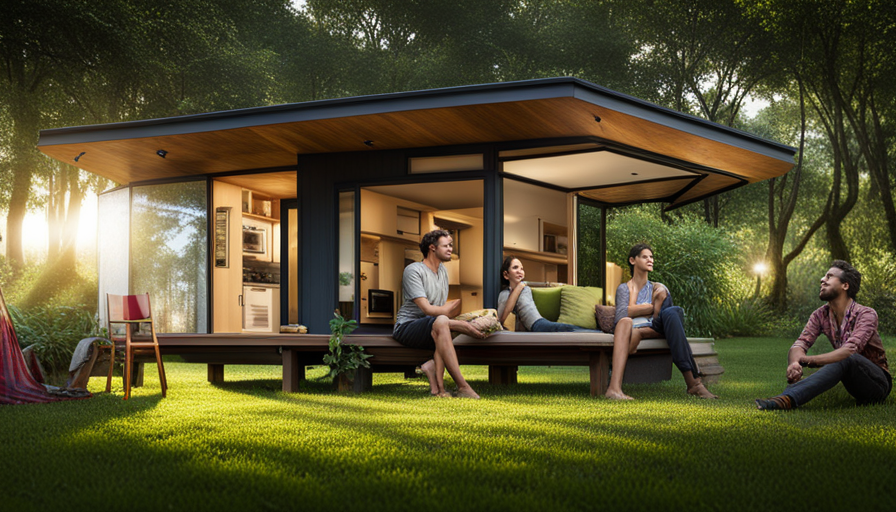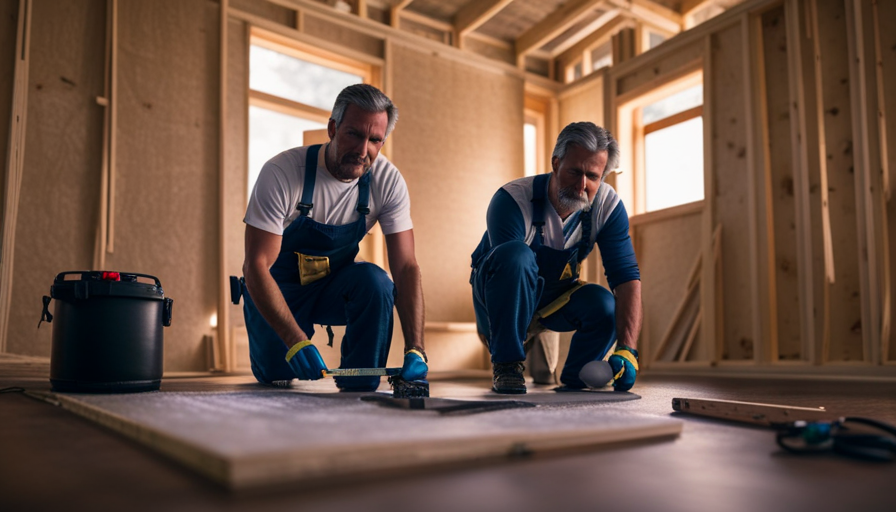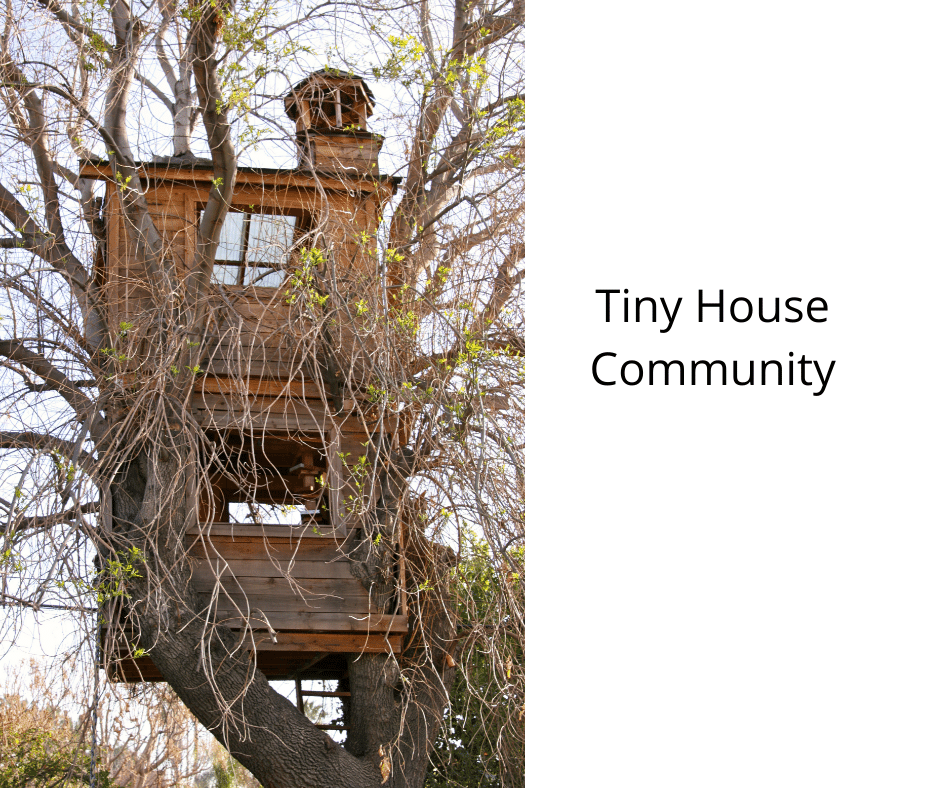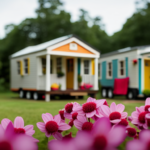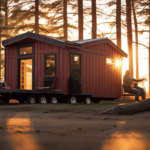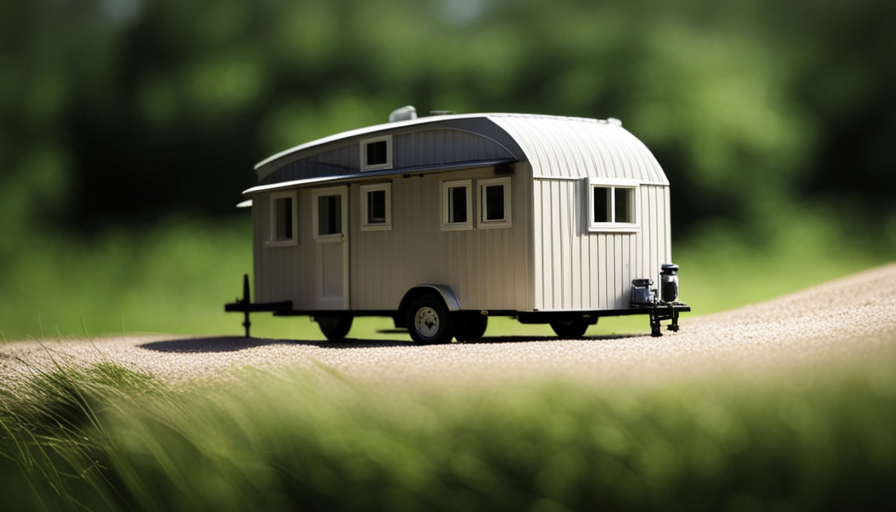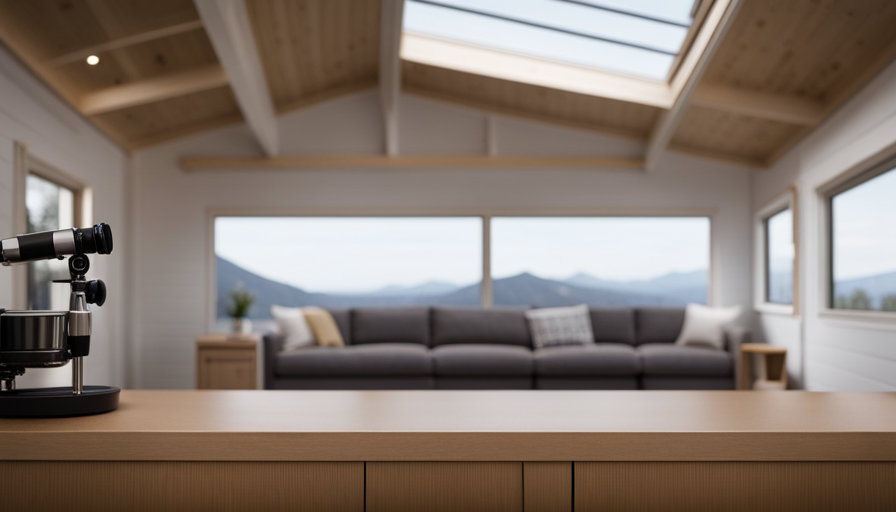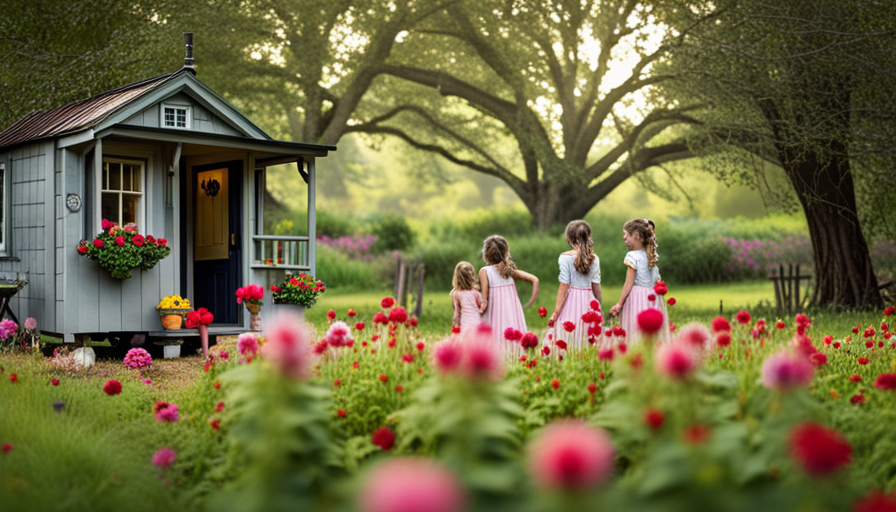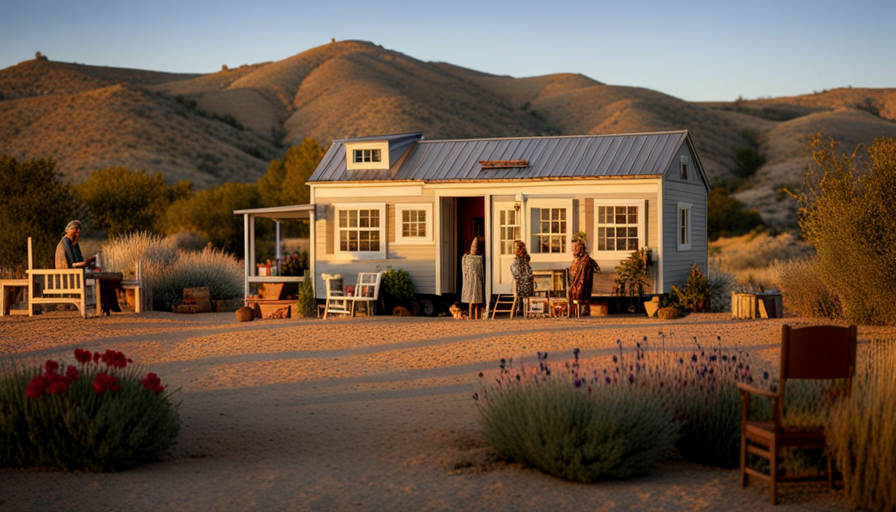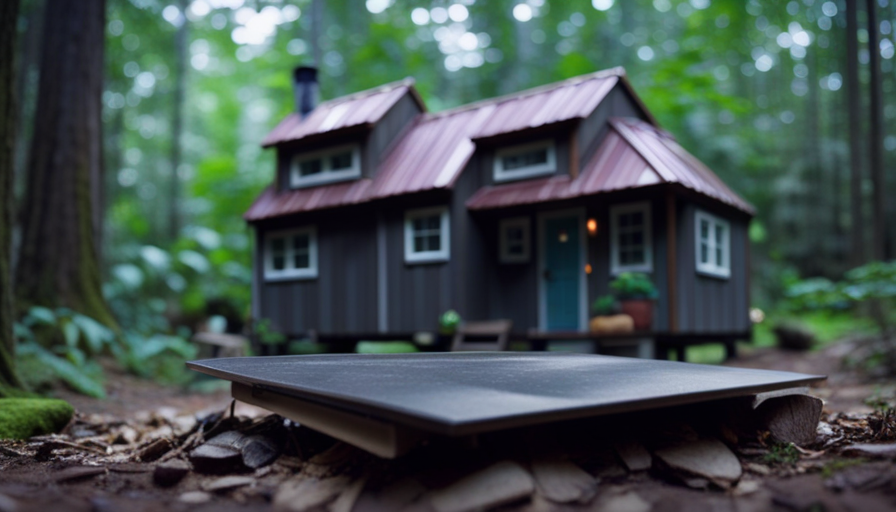Have you ever imagined living in a comfortable, environmentally friendly, and budget-friendly home? Picture a community where people with similar values join forces to establish an innovative, caring, and eco-conscious lifestyle.
Starting a tiny house community may seem like a daunting task, but with careful planning and determination, it can become a reality. In this article, I will guide you through the necessary steps to establish your very own tiny house community.
From researching and securing financing to finding the perfect location and developing community guidelines, we will explore the essential elements needed to bring your vision to life.
By collaborating with local authorities and organizations, establishing sustainable practices, and fostering a strong sense of community, you can create a thriving and fulfilling environment for everyone involved.
So, let’s dive in and discover how to make your dream of starting a tiny house community a reality.
Key Takeaways
- Research and engage with existing tiny house communities to gather knowledge and insights
- Secure financing and funding through various channels such as bank loans, grants, and crowdfunding
- Find a suitable location that offers proximity to amenities, services, and transportation accessibility
- Foster community engagement and environmental stewardship through shared activities, sustainable practices, and regular gatherings
Research and Planning
Now that you’ve decided to dive into the world of tiny house communities, it’s time to start researching and planning to turn your dream into a reality.
The first step is to explore various research methods that will help you gather information about existing tiny house communities. You can start by conducting online research, reading books and articles, and attending tiny house events and workshops. Additionally, reaching out to individuals who have successfully established their own communities can provide valuable insights and guidance.
Engaging with the community is also crucial during the research phase. By attending local meetings, participating in online forums, and connecting with like-minded individuals, you can gather ideas, build relationships, and gain a better understanding of the specific needs and challenges of your future community.
With a solid foundation of research and community engagement, you can now move on to securing financing and funding for your project.
Secure Financing and Funding
When it comes to securing financing and funding for a tiny house community, there are several key points to consider.
First, it is important to explore different financing options for both land purchase and infrastructure development. This could include traditional bank loans, grants, or even partnerships with local organizations.
Additionally, crowdfunding or community investment opportunities should be considered as a way to gather financial support from a wider network.
Lastly, creating a comprehensive budget and financial plan for the project is crucial to ensure that all costs are accounted for and the community remains financially sustainable in the long term.
Explore financing options for land purchase and infrastructure development
To kickstart the process of starting a tiny house community, it’s essential to delve into the various financing options available for purchasing land and developing the necessary infrastructure. Here are three financing options to consider:
-
Explore Banks: Approach local banks and credit unions to inquire about loans specifically designed for land purchase and infrastructure development. Many financial institutions offer favorable terms and interest rates for community development projects.
-
Grants: Research and apply for grants aimed at supporting sustainable housing initiatives and community development. There are numerous organizations and government programs that provide funding for projects aligned with their mission.
-
Crowdfunding or Community Investment: Consider leveraging the power of crowdfunding platforms or seeking community investment to raise funds for your tiny house community. Engage with like-minded individuals and potential residents who are passionate about the concept and willing to invest in its success.
By exploring these financing options, you can secure the necessary funds to purchase land and develop the infrastructure required for your tiny house community.
In the next section, we’ll discuss how to consider crowdfunding or community investment opportunities to further support your project.
Consider crowdfunding or community investment opportunities
Consider tapping into the power of crowdfunding or community investment to rally support and financial backing for your vision of creating a thriving and sustainable haven for like-minded individuals in need of affordable and environmentally-friendly housing options. Crowdfunding has become increasingly popular as a means to raise funds for various projects, and starting a tiny house community is no exception. By utilizing online platforms, you can reach a wider audience and attract individuals who believe in your cause. Community investment models also offer a unique opportunity to engage local residents who may be interested in investing in the development of the community. These models allow for shared ownership and decision-making, fostering a sense of community involvement and empowerment. By combining these two approaches, you can not only raise the necessary funds for land purchase and infrastructure development but also build a strong and supportive community from the very beginning. As you explore these financing options, it is important to create a budget and financial plan for the project, ensuring that all aspects are accounted for and that the community remains financially sustainable in the long run.
To create a budget and financial plan for the project, you need to carefully assess all the costs involved, including land acquisition, infrastructure development, permits, and ongoing maintenance expenses. It is crucial to consider both the initial investment and the ongoing operational costs to ensure the project’s financial viability. Additionally, conducting a market analysis can help you determine the potential demand for tiny house living in your target area and estimate the potential revenue streams. This information will guide your decision-making process and allow you to make informed choices regarding pricing, rental fees, or any other financial aspects of the community. By creating a comprehensive budget and financial plan, you can demonstrate the project’s feasibility to potential investors, lenders, or community members who may contribute financially.
Create a budget and financial plan for the project
With the right financial plan in place, your vision for a thriving and sustainable haven can blossom into a flourishing garden of opportunity.
To start, it’s crucial to develop a fundraising strategy that aligns with your goals and values. Consider crowdfunding platforms, community investment opportunities, or seeking grants from organizations that support affordable housing initiatives.
Additionally, identify potential revenue streams that can sustain the community in the long term. This could include renting out common spaces or offering services to the wider community.
Creating a budget is essential to ensure that your financial plan is realistic and achievable. Take into account construction costs, land acquisition, utilities, and ongoing maintenance.
By carefully considering these factors and developing a sound financial plan, you can set your tiny house community on a solid foundation for success.
Moving forward, let’s explore how to find the perfect location for your community.
Find the Perfect Location
When looking for the perfect location for a tiny house community, it’s important to find land that meets the specific needs of the community. This includes considering factors such as size, zoning regulations, and access to utilities.
Additionally, proximity to amenities and services is crucial for the convenience and well-being of the residents.
Lastly, evaluating the potential for future growth and expansion is essential to ensure the long-term success and sustainability of the community.
By carefully considering these key points, we can find a location that’ll provide an ideal setting for a thriving and vibrant tiny house community.
Look for land that meets the needs of a tiny house community
First, you’ll want to find the perfect plot of land that perfectly caters to the needs and desires of your dreamy tiny house community.
Land availability is a crucial factor to consider when starting a tiny house community. Look for areas where land is readily available and can accommodate multiple tiny houses. Additionally, it’s important to research and understand the zoning requirements in the chosen location. Ensure that the land is zoned appropriately for a residential community and that tiny houses are allowed. This will save you time and potential legal issues in the future.
Once you have identified a suitable location, consider proximity to amenities and services. Access to grocery stores, healthcare facilities, and public transportation will enhance the livability of your tiny house community and make it more attractive to potential residents.
Consider proximity to amenities and services
When looking for land to establish a tiny house community, it’s crucial to find a location that not only meets the needs of the community but also provides easy access to amenities and services. Proximity to transportation accessibility is key, ensuring that residents have convenient options for commuting and exploring the surrounding area.
Additionally, having local businesses and shops nearby is essential for meeting daily needs and fostering a sense of community. Whether it’s a grocery store, a coffee shop, or a pharmacy, having these amenities within a short distance can greatly enhance the quality of life for tiny house residents.
By considering proximity to amenities and services, we can create a vibrant and self-sustaining community that meets the needs of its members.
Now, let’s evaluate the potential for future growth and expansion.
Evaluate the potential for future growth and expansion
Assessing the potential for future growth and expansion is crucial for creating a thriving and sustainable community. To evaluate the future expansion potential of a tiny house community, conducting a market analysis is essential. This analysis involves examining factors such as demand for affordable housing options, population growth projections, and the availability of land for development.
By understanding these key components, community leaders can make informed decisions about the feasibility of growth and expansion. Additionally, it allows for strategic planning to accommodate potential increases in residents and infrastructure requirements.
Furthermore, considering the long-term sustainability of the community is vital. This can involve incorporating eco-friendly practices, exploring renewable energy options, and implementing efficient waste management systems.
With a solid understanding of the future expansion potential and sustainability goals, it’s possible to develop community guidelines and rules that support the envisioned growth and ensure the well-being of all residents.
Develop Community Guidelines and Rules
To create a vibrant and harmonious tiny house community, it’s crucial to establish community guidelines and rules that promote inclusivity, sustainability, and respect for one another’s personal space. Here are four key considerations when developing guidelines and rules for community members:
-
Clear Boundaries: Clearly define expectations regarding noise levels, property maintenance, and shared spaces to ensure everyone understands their responsibilities.
-
Conflict Resolution: Implement a structured process for resolving conflicts, such as open dialogues or mediation sessions, to maintain harmony and address issues promptly.
-
Environmental Stewardship: Encourage sustainable practices like composting, recycling, and energy conservation to minimize the community’s ecological footprint.
-
Community Engagement: Foster a sense of belonging by organizing regular gatherings, social events, and shared activities that encourage interaction and collaboration among residents.
By establishing these guidelines and rules, we can cultivate a thriving tiny house community where everyone feels heard, respected, and supported.
Next, we will explore how to build infrastructure and utilities to ensure the community’s functionality and comfort.
Build Infrastructure and Utilities
Create an environment that fosters comfort and functionality by building the necessary infrastructure and utilities for our thriving community.
When it comes to building a tiny house community, it’s crucial to carefully design the architecture and infrastructure to meet the unique needs of our residents. Start by considering the layout of the community, ensuring that each tiny house has adequate space and privacy.
Additionally, think about the amenities that will enhance the quality of life for our community members, such as communal spaces, gardens, and recreational areas. Don’t forget about the utilities that are essential for daily living, like water, electricity, and waste management systems.
By investing time and resources into the construction of a well-designed and well-equipped community, we can create a space that brings people together and fosters a sense of belonging.
Transitioning into the subsequent section about ‘recruit and select community members,’ we can now focus on finding the right individuals who align with our values and vision.
Recruit and Select Community Members
Finding the right individuals who align with our values and vision is crucial for building a thriving community that feels like home. We employ various recruiting strategies to attract potential community members who share our passion for sustainable living and desire to create a close-knit community. Our community membership criteria include factors such as commitment to environmental stewardship, willingness to actively participate in communal activities, and a positive attitude towards collaboration and shared decision-making. To ensure transparency and fairness, we have developed a comprehensive application process that involves interviews, background checks, and reference checks. By carefully selecting individuals who embody our core values, we create a harmonious environment where everyone contributes to the well-being of the community. In the next section, we will explore how we collaborate with local authorities and organizations to further enhance our tiny house community’s success and impact.
Collaborate with Local Authorities and Organizations
After successfully recruiting and selecting community members, the next crucial step in starting a tiny house community is to collaborate with local authorities and organizations.
Engaging local stakeholders is essential as it allows them to understand the benefits of a tiny house community and address any concerns they may have. By involving community members in these collaborations, it fosters a sense of ownership and ensures their needs and ideas are incorporated into the planning process.
Local authorities can provide guidance on zoning regulations and building codes, while organizations such as nonprofits or housing agencies can offer valuable resources and support. Building strong relationships with these entities is key to navigating the legal and logistical aspects of creating a tiny house community.
By establishing these partnerships, we can lay a solid foundation for the subsequent section on how to establish sustainable practices.
Establish Sustainable Practices
To ensure the long-term viability of the community, it’s essential to establish sustainable practices that promote environmental stewardship and resource conservation. This can be achieved through the implementation of sustainable construction techniques and waste management strategies. By using environmentally-friendly materials and practices, such as using recycled or reclaimed materials, installing energy-efficient appliances, and implementing renewable energy sources, the community can minimize its carbon footprint and reduce its impact on the environment. Additionally, implementing effective waste management strategies, such as recycling programs and composting facilities, can help minimize waste and promote a circular economy within the community.
To grab the attention of the audience, here is a table showcasing some sustainable construction techniques and waste management strategies:
| Sustainable Construction Techniques | Waste Management Strategies | Resource Conservation Measures |
|---|---|---|
| Use of recycled or reclaimed materials | Recycling programs | Energy-efficient appliances |
| Installation of renewable energy sources | Composting facilities | Water conservation measures |
| Implementing passive design strategies | Waste reduction initiatives | Sustainable landscaping |
By adopting these sustainable practices, the community can not only contribute to a healthier environment but also create a more resilient and self-sufficient living environment for its residents.
Transition: Now that we have established the importance of sustainable practices, let’s explore how to foster a sense of community and connection within the tiny house community.
Foster a Sense of Community and Connection
When it comes to fostering a sense of community and connection in a tiny house community, there are a few key points to consider.
First and foremost, it’s important to organize regular community events and gatherings where residents can come together and get to know one another. This can help to build relationships and create a sense of belonging.
Additionally, encouraging residents to participate in decision-making processes can help to foster a sense of ownership and investment in the community.
Finally, creating spaces for shared activities and social interaction can provide opportunities for residents to come together and engage in meaningful connections.
By implementing these strategies, a strong sense of community can be fostered in a tiny house community.
Organize regular community events and gatherings
Don’t just sit around waiting for a miracle to happen, you should be throwing epic parties and hosting amazing events to create a thriving tiny house community. Regular community events and gatherings are essential for fostering a sense of belonging and connection among residents.
By organizing these events, you provide opportunities for people to come together, socialize, and build relationships. Whether it’s a potluck dinner, a game night, or a community cleanup day, these gatherings help to create a vibrant and engaged community. They also allow residents to share ideas, discuss common issues, and collaborate on projects that benefit the entire community.
Additionally, these events can be a great way to showcase the unique aspects of your tiny house community and attract potential new residents. By hosting regular events, you lay the foundation for a strong and united community. Encouraging residents to participate in decision-making processes is another crucial step in building a thriving tiny house community.
Encourage residents to participate in decision-making processes
Get residents involved and make their voices heard by actively encouraging their participation in decision-making processes. Resident engagement is crucial for a thriving tiny house community. Here are some strategies to encourage participation in decision making:
-
Hold regular community meetings where residents can voice their opinions and concerns.
-
Establish a resident-led committee to facilitate communication and decision-making.
-
Use online platforms or apps to gather feedback and suggestions from residents.
-
Conduct surveys to gauge resident preferences and priorities.
-
Provide training or workshops to empower residents with the skills needed for effective decision making.
By actively involving residents in the decision-making processes, the community can ensure that everyone’s needs and perspectives are taken into account. This fosters a sense of ownership and empowerment among residents, leading to a stronger and more cohesive community.
In the next section, we’ll explore how to create spaces for shared activities and social interaction.
Create spaces for shared activities and social interaction
To truly bring the tiny house neighborhood to life, it’s essential to cultivate spaces that buzz with shared activities and vibrant social interaction, creating a kaleidoscope of connections and friendships.
Shared amenities play a crucial role in fostering community engagement and creating opportunities for residents to come together. Designating common areas for activities such as community gardens, outdoor seating, and recreational spaces can encourage interaction and a sense of belonging. These spaces can be used for group events, workshops, and even informal gatherings, allowing residents to bond over shared interests and passions.
Additionally, incorporating shared amenities like a clubhouse, gym, or communal kitchen can further enhance the sense of community and provide opportunities for residents to connect and collaborate. By continuously evaluating and improving these spaces based on resident feedback, we can ensure that our tiny house community remains vibrant and supportive, promoting a strong sense of togetherness.
Continuously Evaluate and Improve
Regularly assessing our community’s strengths and areas for improvement is crucial to its success. By seeking feedback from residents and implementing necessary changes, we can ensure that our community is continuously improving and meeting the needs of its members.
As needs and challenges evolve, it’s important for us to adapt and find innovative solutions in order to sustain the success of our community.
Regularly assess the community’s strengths and areas for improvement
Assessing the community’s strengths and areas for improvement can help foster a sense of collective growth and progress. By regularly evaluating the dynamics within the tiny house community, we can identify what is working well and what needs attention.
This comprehensive assessment allows us to address community concerns and find solutions to enhance the overall living experience. We can evaluate the effectiveness of our communal spaces, the efficiency of our shared resources, and the satisfaction levels of our residents. By analyzing these factors, we can identify areas where improvements can be made, such as enhancing the infrastructure or implementing new community programs.
Seeking feedback from residents and implementing necessary changes based on their input will ensure that we are continuously evolving and adapting to meet the needs and desires of our community members. Transitioning into the next section, it is essential to actively involve residents in shaping the future of our tiny house community.
Seek feedback from residents and implement necessary changes
Engage with residents and actively listen to their input to ensure a thriving, evolving community that reflects their desires and needs. Seeking feedback from residents is crucial in creating a tiny house community that meets their expectations. By regularly gathering input through surveys, community meetings, and informal conversations, we can gain valuable insights into their experiences and identify areas for improvement. To facilitate this process, we have implemented a feedback system that allows residents to submit suggestions and concerns anonymously. This ensures that everyone feels comfortable expressing their thoughts and opinions. Once feedback is received, we carefully analyze the data and prioritize the necessary changes. Whether it’s addressing maintenance issues, enhancing community amenities, or adjusting policies, we strive to implement changes that will positively impact the community as a whole. By actively involving residents in decision-making, we foster a sense of ownership and empowerment within the community. This collaborative approach not only strengthens the bond between residents but also contributes to the overall success of the community. Transitioning into the next section, we will discuss how we adapt to evolving needs and challenges in order to sustain the community’s success.
Adapt to evolving needs and challenges in order to sustain the community’s success
In order to ensure the long-term prosperity of our thriving and ever-evolving community, we must continuously adapt and overcome the ever-changing needs and challenges that come our way. It is crucial to establish a sustainable infrastructure that can support the growing demands of our tiny house community.
This includes developing renewable energy sources, implementing efficient waste management systems, and creating shared spaces that promote green living.
Additionally, resident engagement plays a vital role in sustaining our community’s success. We must foster a strong sense of belonging among our residents by organizing regular community events, encouraging open communication channels, and providing opportunities for collaboration and involvement.
By actively involving our residents in decision-making processes and seeking their input, we can ensure that our community remains responsive to their evolving needs and desires. Together, we can create a resilient and thriving tiny house community that serves as a model for sustainable living.
Frequently Asked Questions
How can I ensure the long-term sustainability of my tiny house community?
To ensure the long-term sustainability of my tiny house community, I’ll focus on securing long-term financing options and promoting environmental sustainability.
I’ll explore various funding sources such as grants, loans, and crowdfunding to support ongoing community expenses.
Additionally, I’ll implement eco-friendly practices like using renewable energy sources, reducing waste through recycling and composting, and promoting sustainable transportation options.
These measures will contribute to the financial stability and environmental consciousness of my community.
What are some common challenges faced when building infrastructure and utilities for a tiny house community?
When building infrastructure and utilities for a tiny house community, common challenges arise.
The permitting process can be complex, requiring extensive documentation and adherence to regulations.
Securing infrastructure funding can also be a hurdle, as it often involves navigating grant applications and securing loans.
However, by thoroughly researching the permitting process and exploring various funding options such as government grants, crowdfunding, and partnerships, these challenges can be overcome.
Solutions include seeking professional assistance, forming a dedicated team, and actively engaging with local government officials.
How can I engage and collaborate with local authorities and organizations to gain support for my tiny house community?
Engaging local authorities, securing funding, and building partnerships are crucial steps in gaining support for a tiny house community.
Community outreach is essential to inform and educate local authorities and organizations about the benefits of tiny house living. By presenting a well-structured proposal that addresses zoning regulations and potential concerns, public support can be garnered.
Additionally, forming partnerships with organizations that share a similar vision can provide access to resources and expertise. Together, these efforts can pave the way for a successful tiny house community.
What are some effective ways to foster a sense of community and connection among the residents of a tiny house community?
To foster a sense of community and connection among the residents of a tiny house community, organizing community events is essential. These events can include potlucks, movie nights, workshops, and other activities that encourage interaction and collaboration.
Additionally, implementing effective communication strategies such as creating a community newsletter, establishing online forums or social media groups, and organizing regular community meetings can help maintain open lines of communication and ensure that residents feel heard and connected to one another.
What are some key indicators or metrics that can be used to continuously evaluate and improve a tiny house community’s success?
Continuous improvement and success evaluation are crucial for the long-term sustainability of a tiny house community. One interesting statistic to consider is the resident satisfaction rate, which can be measured through regular surveys or feedback sessions. This metric provides valuable insights into the community’s overall well-being and helps identify areas that need improvement.
Additionally, tracking the community’s financial stability, occupancy rate, and resident turnover rate can offer a comprehensive picture of its success and guide future enhancements. By consistently monitoring these indicators, we can ensure the continuous growth and prosperity of our tiny house community.
Conclusion
In conclusion, starting a tiny house community requires careful research, diligent planning, and secure financing.
Finding the perfect location and developing community guidelines are essential steps in creating a thriving community.
Building infrastructure and collaborating with local authorities ensure a sustainable and well-functioning community.
By establishing sustainable practices and fostering a strong sense of community, residents can enjoy a connected and fulfilling lifestyle.
Continuous evaluation and improvement are key to maintaining the success of the community.
With dedication and perseverance, anyone can create their own tiny house community and embrace the benefits it offers.
Hi, I’m Emma. I’m the Editor in Chief of Tiny House 43, a blog all about tiny houses. While tree houses are often associated with childhood, they can be the perfect adult retreat. They offer a cozy space to relax and unwind, surrounded by nature. And since they’re typically built on stilts or raised platforms, they offer stunning views that traditional homes simply can’t match. If you’re looking for a unique and romantic getaway, a tree house tiny house might just be the perfect option.
